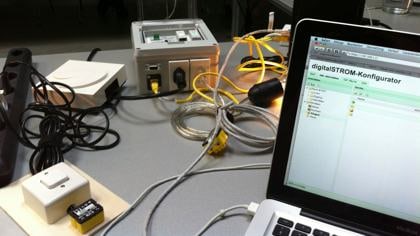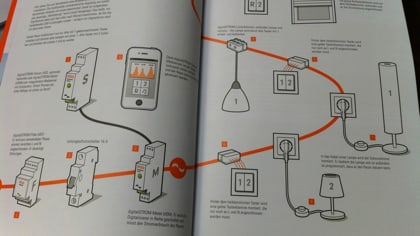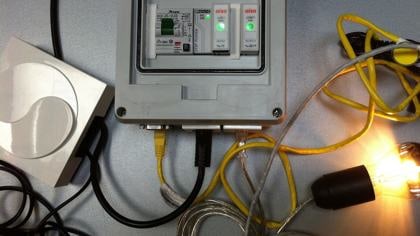The Internet of Things is currently being talked about a lot as the next big thing.

A group of Liipers participated in the second digitalSTROM Hacker day in order to get some hands-on experience of what the future beholds in the world of web enabled “ smart devices “.
Introducing: DigitalSTROM.org
digitalSTROM.org was founded in 2007 at the Swiss Federal Institute of Technology Zurich (ETHZ) as a non-profit organization. The goal of the organization is to establish the digitalSTROM technology as a standard to allow networking of electrical devices .
The core of the digitalSTROM technology is the dS micro chip. Each electrical device that is equipped with a dS chip is turned into a “smart device”.
The smart devices communicate with one another over existing electrical wiring. Thus, it is possible turn an existing electrical network into a digitalSTROM network, without additional cabling.
In order to achieve this, you need a dSID chip for each device, fitted by the way of an electrical connector (dS terminal block), and a dS meter for each electrical circuit, fitted into the fuse box. All devices within an electrical circuit then become “addressable”, allowing them to be turned on and off, and dimmed, from any dS-enabled switch. Each circuit equipped with these components allows for some base functionality. For example, triggering pre-defined lighting “mood” configurations.

The base system can be extended by adding a dS server. The server acts as a gateway and allows networking between dS meters (i.e. communicating across electrical circuits). The dS server opens up the playing field for many new applications. For example, it's possible to monitor the power consumption of all individual devices within a complete household, in near real-time.
The dS server (dSS) also provides a web server. Thus it's possible to connect the “smart devices” to the local network or to the internet, allowing (secure) bi-directional communication to any device. The software of the dS server is available as open source (GPL, dual licensing). The dS server provides a SOAP web service interface, as well as a HTTP based JSON interface.
Thus, developers can use their existing know-how to build new applications, e.g. for controlling household appliances via smart phone.
digitalSTROM Hacker Day
Six Liipers participated in the second “digitalSTROM Hacker day” on July 12th.
The event was an opportunity to learn about the digitalSTROM Server, exchange ideas and experiences, and to experiment with the digitalSTROM hardware, which was provided by aizo for the duration of the workshop.

The event was kicked off with four presentations about the dS server, the AccessHUB, the dS development kit, dSS JSON Interface and an introduction on how to develop dSS applications.
Brainstorming Innovative Ideas for digitalSTROM
Over lunch, we talked about how to make best use of this exciting new technology. Someone from aizo mentioned the potential of the digitalSTROM-Standard in the management of power peaks, e.g. programming washing machines to run only during times of low power demand (at reduced energy costs).
It occurred to me that we could leverage the collective brain power of the workshop participants to come up with inspiring scenarios for the hands-on experimentation with the digitalSTROM development kits. I spontaneously volunteered to run a 3-12-3 Brainstorming session. The participants came up with some interesting use cases, e.g.:
- A monitoring and alerts scenario: metering the power consumption of devices in a building and reacting on anomalies. For example, a fridge has regular peaks of power use during cooling. If no peaks are measured during a certain period, this could trigger an alarm (e.g. send an sms alert) that the fridge might not work correctly.
- A holiday housing estates scenario: The occupants of holiday resorts frequently change. The resort caretakers could centrally switch all appropriate devices – such as lights and heating – on just before the occupants arrive (and switch everything off after departure).
After each group presented their ideas, we spent the rest of the afternoon experimenting hands-on. Most people opted to build a small web app, communicating with the digitalSTROM Server via RESTful web service.

The aizo folks and the developers from the digitalSTROM.org community proved to be great hosts, answering our technical questions, providing personal tours in the aizo show room and discussing uses of the technology.
Conclusion from a Business Perspective
For individuals, the digitalSTROM units (dS meters and dS server) are still too costly compared to the potential energy cost savings (since energy cost is still very low).
However, home owners and tenants benefit from the flexibility of the system. An electrical engineer can reconfigure the power network layout electronically, without costly change to the physical wiring.
For developers, the digitalSTROM system has a very web developer friendly architecture and the dS server software is open source. On the downside, the dS hardware seems (still) too expensive (for hobbyists) and is not open sourced, which might limit the adoption by technology enthusiasts and tinkerers.
It is clear though that there are lots of possibilities for innovative applications. May it be in the area of power metering as a learning tool (i.e. becoming smarter about power consumption), remote control of home devices (e.g. via smart phone) or home automation .
It turns out, with digitalSTROM, the vision of the Web of Things is already part of reality.
